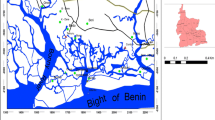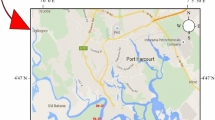Abstract
Dissolved copper and selected water chemistry parameters were monitored for 11 months in Chesapeake Bay, U.S.A. Dissolved copper concentrations in four recreational marinas, a large harbor, two major river systems, and a heavily used shipping canal ranged from below detectable levels to 80 μg L-1 (\-X=11.7 μg L-1). Dissolved copper was detected >91% of the time at five locations. Lowest copper concentrations were found in Potomac River, Baltimore Harbor, Pier One Marina, and C & D Canal (\-X=6–10 μg L-1; slightly higher levels of dissolved copper were found in Choptank River (\-X=12 μg L-1). Highest levels of copper were detected in Port Annapolis, Hartge, and Piney Narrows Marinas (\-X=13–18 μg L-1), with the highest values observed in the study (70 and 80 μg L-1) found in two of these marinas. Copper in the three marinas with highest dissolved copper levels could have been toxic to some of the more sensitive aquatic species. Intensive study of one marina indicated that a likely source of dissolved copper was the recreational boats housed in the marina.
Similar content being viewed by others
References
APHA, AWWA, WPCF: 1985, ‘Standard Methods for the Examination of Water and Wastewater’, APHA, Washington, DC, 1268 pp.
Bender, M. L. and Gagner, C.: 1976, ‘Dissolved Copper, Nickel, and Cadmium in the Sargasso Sea’, J. Mar. Res. 34, 327–339.
Boyle, E. A.: 1979, ‘Copper in Natural Waters’, in Nriagu, J. O., (ed.), Copper in the Environment. Part. I: Ecological Cycling, Wiley Publ. Co. New York, N.Y., 77 pp.
Calabrese, A., MacInnes, J. R., Nelson, D. A., and Miller, J. E.: 1977, ‘Survival and Growth of Bivalva Larvae Under Heavy Metal Stress’, Mar. Biol. 41, 179–184.
Chakoumakos, C., Russo, R. C., and Thurston, R. V.: 1979, ‘The Toxicity of Copper to Cutthroat Trout (Salmo clarki) Under Different Conditions of Alkalinity, pH, and Hardness’, Environ. Sci. Tech. 13, 213–219.
Davey, E. W., Morgan, M. J., and Erickson, S. J.: 1973, ‘A Biological Measurement of the Copper Complexation Capacity of Seawater’, Limnol. and Oceanog. 18, 993–997.
Dodge, E. E. and Theis, T. L.: 1979, ‘Effect of Chemical Specification on the Uptake of Copper by Chrionomus Tentans’, Environ. Sci. Tech. 13, 1287–1290.
Florence, T. M. and Stauber, J. L.: 1986, ‘Toxicity of Copper Complexes to the Marine Diatom Nitzchia Closterium’, Aquat. Toxicol. 8, 11–26.
Greensberg, R. R. and Kingston, H. M.: 1983, ‘Trace Element Analysis of Natural Water Samples by Neutron Activation Analysis with Chelating Resin’, Anal. Chem. 55, 1160–1165.
Hall, L. W.Jr., Pinkney, A. E., Horseman, L. O., and Finger, S. E.: 1985, ‘Mortality of Striped Bass Larvae in Relation to Contaminants and Water Quality in a Chesapeake Bay Tributary’, Trans. Am. Fish. Soc. 114, 861–868.
Hall, L. W.Jr., Pinkney, A. E., Herman, R. L., and Finger, S.E.: 1987a, ‘Survival of Striped Bass Larvae and Yearlings in Relation to Contaminants and Water Quality in Upper Chesapeake Bay’, Arch. Env. Contam. Toxicol. 16, 391–400.
Hall, L. W.Jr., Hall, W. S., Bushong, S. J., and Herman, R. L.: 1987b, ‘In-situ striped bass (Morone saxatilis) contaminant and water quality studies in the Potomac River’, Aqt. Toxicol 10, 73–99.
Hall, L. W.Jr., Lenkevich, M. J., Hall, W. S., Pinkney, A. E., and Bushong, S. J.: 1987c, ‘Evaluation of Butyltin Compounds in Maryland waters of Chesapeake Bay’, Mar. Poll. Bull. 18, 78–83.
Harrison, F. L.: 1982, ‘A Review of the Impact of Copper Released into Marine and Estuarine Environments’, Report No. NUREG/CR-2823, UCRL-53042, Office of Nuclear Regulatory Research, Washington, D.C.
Howarth, R. S. and Sprague, J. B.: 1978, ‘Copper Lethality to Rainbow Trout in Waters of Various Hardness and pH’, Water Res. 12, 455–462.
Huggett, R. J., Bender, M. E., and Slone, H. D.: 1973, ‘Utilizing Metal Concentration Relationships in the Eastern Oyster (Crassostrea virginica) to Detect Heavy Metal Pollution’, Water Res. 7, 451–460.
Huggett, R. J., Cross, F. A., and Bender, M. E.: 1975, ‘Distribution of Copper and Zinc in Oysters and Sediments from Three Coastal Plain Estuaries, in Proceedings of a Symposium on Mineral Cycling in Southeastern Ecosystems, U.S. Energy Research and Development Administration, Conf. 740513, pp. 224–238.
Ibragin, A. M. and Patin, S. A.: 1975, ‘Effect of Mercury, Lead, Cadmium, and Copper on Primary Production of Phytoplankton in Some Coastal Regions of the Mediterranean and Red Sea’, Oceanol. 15, 589–591.
Kingston, H. M., Barnes, I. L., Brady, T. J., Rains, T. C., and Champ, M. A.: 1978, ‘Separation of Eight Transition Elements from Alkali and Alkaline Earth Elements in Estuarine and Seawater and Chelating Resin and Their Determination by Graphite Furnace Atomic Absorption Spectrometry’, Anal. Chem. 50, 2064–2070.
Kingston, H. M., Greenberg, R. R., Beary, E. S., Hardas, B. R., Moody, J. R., Rains, T. C., and Liggett, W. S.: 1983, ‘The Characterization of Chesapeake Bay: A Systematic Analysis of Toxic Trace Elements’, U.S. Dept. Comm. National Bureau of Standards, Washington, DC., 218 pp.
Martin, M., Osborn, K. E., Billig, P., and Glickstein, N.: 1981, ‘Toxicities of Ten Metals to Crassostrea Gigas and Mytilus Edulis Embryeos and Cancer Magister Larvae’, Mar. Poll. Bull. 12, 205–308.
Pagenkopf, G. K.: 1983, ‘Gill Surface Interaction Model for Trace-metal Toxicity to Fishes: Role of Complexation, pH, and Water Hardness’, Environ. Sci. Tech. 17, 342–345.
Pesch, C. E. and Hoffman, G. L.: 1982, ‘Adaptation of the Polychaete worm Neanthes Arenaceodentata to Copper’, Mar. Environ. Res. 6, 307–317.
Pesch, E. C. and Morgan, D.: 1978, ‘Influence of Sediment in Copper Toxicity Tests with the Polychaete Neanthes Arenaceodentate’, Water Res. 12, 747–751.
Peterson, R.: 1982, ‘Influence of Copper and Zinc on the Growth of a Freshwater Algae, Scenedesmus guadricauda: Significance of Specification, Environ. Sci. Tech. 16, 443–447.
Saward, D., Stirling, A., and Topping, G.; 1975, ‘Experimental Studies on the Effects of Copper on a Marine Food Chain’, Mar. Biol. 29, 351–361.
Schmidt, R. L.: 1978, ‘Copper in the Marine Environment. Part 2. CRC Critical Review Environmental Control’, 8, 247–291.
Sosnowski, D. L. and Gentile, J. H.: 1978, ‘Toxicological Comparison of Natural and Cultured Populations of Acartia Tonsa to Cadmium, Copper, and Mercury’, J. Fish. Res. Bd. Can. 35, 1366–1369.
Sunda, W. G. and Guillard, R. R. L.: 1976, ‘The Relationship between Cupric Ion Activity and the Toxicity of Copper to Phytoplankton’, J. Mar. Res. 34, 511–529.
U.S. EPA (United States Environmental Protection Agency): 1980, ‘Implementation Status of State 208 Agricultural Programs: Summary of the Harbridge House Review of State Agricultural Nonpoint Program Status and Implementation Readiness’, U.S. EPA. Washington, D.C.
U.S. EPA (United States Environmental Protection Agency): 1983, ‘Chesapeake Bay: A Framework for Action’, Chesapeake Bay Program. Annapolis, MD.
U.S. EPA (United States Environmental Protection Agency): 1985, ‘Ambient Water Quality Criteria for Copper — 1984’, EPA 440/5/-84-031. Office of Water Regulations and Standards. Washington, D.C.
Author information
Authors and Affiliations
Rights and permissions
About this article
Cite this article
Hall, W.S., Bushong, S.J., Hall, L.W. et al. Monitoring dissolved copper concentrations in Chesapeake Bay, U.S.A.. Environ Monit Assess 11, 33–42 (1988). https://doi.org/10.1007/BF00394510
Issue Date:
DOI: https://doi.org/10.1007/BF00394510




